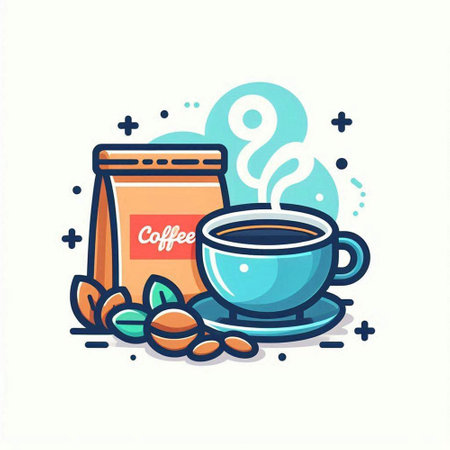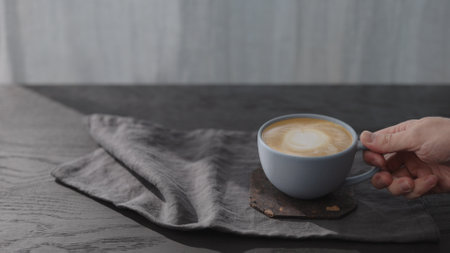1. Setting the Scene: Creating the Perfect Tasting Environment
Hosting a pour over coffee tasting at home is all about making your guests feel welcome and setting the stage for a memorable experience. Here’s how you can create an inviting atmosphere that’s perfect for exploring different brews together.
Choose the Right Music
Background music can really set the mood. Opt for something mellow and upbeat, like indie folk or smooth jazz—nothing too loud or distracting. The goal is to have music that encourages conversation but doesn’t overpower it.
Lighting Matters
Lighting plays a big role in creating a cozy vibe. If you’re hosting during the day, let natural light fill the space. For evening tastings, use warm-toned lamps or string lights to keep things soft and welcoming. Avoid harsh overhead lighting—it can make things feel sterile instead of comfortable.
Arranging Your Coffee Tasting Table
The way you set up your table can make guests feel at ease and excited to participate. Here are some tips for arranging everything just right:
| Item | Purpose | Tips |
|---|---|---|
| Coffee Carafes or Servers | Hold brewed coffee for tasting | Label each carafe with the coffee’s name and origin |
| Tasting Cups | Allow everyone to sample each brew | Use small cups; set out enough for every guest to have one per coffee type |
| Tasting Sheets & Pens | Note down flavor impressions | Provide simple sheets for scoring aroma, taste, and body |
| Water Pitcher & Glasses | Cleanses palate between tastings | Encourage guests to drink water between pours |
| Light Snacks (e.g., crackers) | Cleanses palate without overpowering flavors | Avoid foods with strong aromas or tastes |
| Name Cards or Placeholders | Adds a personal touch to each seat | A fun way to make everyone feel special |
Decor Touches That Say “Welcome”
Add a few simple decorations—like fresh flowers, a coffee-themed centerpiece, or even quirky mugs—to show your guests you put thought into their experience. Little details go a long way in making your tasting event feel unique and comfortable.
Tip:
If you want to make things extra special, consider sharing a brief story about your favorite coffee or why you love pour over brewing—it’s a great ice breaker and gets everyone excited to taste!
2. Choosing Your Beans: Selecting Coffees to Compare
If you want your pour over coffee tasting at home to be memorable, picking the right beans is key. In the U.S., coffee culture celebrates diversity and storytelling—so your bean selection should reflect that! Here’s how to put together a lineup of coffees that will spark conversation and delight your guests’ taste buds.
Pick a Range: Single-Origin vs. Blends
Start by deciding if you want single-origin coffees, blends, or both. Single-origin beans come from one region or farm and have unique flavors that express their place of origin. Blends mix beans from different places for a balanced profile. For a classic American tasting experience, choose a mix so everyone can notice the differences.
| Coffee Type | What It Offers | Why Include It? |
|---|---|---|
| Single-Origin | Unique flavors, tells a story about its region | Great for exploring terroir (origin flavors) |
| Blend | Smooth, balanced taste; often house favorites | Good for comparing complexity vs. purity |
Source Locally for Freshness & Community Vibes
Support your local coffee scene by buying beans from nearby roasters. American cities are full of passionate small-batch roasters who love to share their latest finds. Ask them about what’s in season or if they have any limited releases for tastings. Not only will you get fresher coffee, but you’ll also have cool stories to tell at your event!
How to Find Local Roasters:
- Check out farmers’ markets and specialty shops
- Search online for top-rated roasters in your city
- Ask friends or social media groups for recommendations
Gather the Story Behind Each Coffee
An American-style tasting isn’t just about flavor—it’s about connection. Get the backstory on each coffee you select: where it’s grown, who the farmers are, what makes it special. Many U.S. roasters offer details about their producers or direct trade partnerships on their websites or packaging. Print out these stories or jot down notes to share with guests during your tasting—it’ll turn every cup into an experience.
Quick Tips:
- Select 3-5 different coffees for variety without overwhelming your palate.
- If possible, pick coffees roasted within the last two weeks for peak freshness.
- Label each bag clearly and keep all info handy for discussion.
This approach not only helps you host a fun pour over coffee tasting at home—it also brings in that classic American love for discovering new flavors and sharing good stories with friends.

3. Gearing Up: Essential Equipment for Pour Over Success
If you want your at-home pour over coffee tasting to shine, having the right gear makes all the difference. Here’s a simple breakdown of what you’ll need, plus some wallet-friendly alternatives if you’re just starting out or don’t want to splurge.
Must-Have Equipment
| Equipment | Why It Matters | Budget-Friendly Substitution |
|---|---|---|
| Pour Over Brewer (e.g., Hario V60, Chemex, Kalita Wave) | The heart of the process—shapes extraction and flavor | Clever Dripper or even a standard drip cone from your local grocery store |
| Pourover Filters (paper or metal) | Keeps grounds out and impacts taste clarity | Unbleached #2 filters found at any supermarket |
| Gooseneck Kettle | Gives you control over water flow and pouring technique | A regular kettle or even a measuring cup with a spout—just pour slowly! |
| Digital Scale | Ensures precise coffee-to-water ratio for consistency between brews | Standard kitchen scale or measure by tablespoons if needed (not as precise, but works in a pinch) |
| Burr Grinder | Freshly ground beans are a game changer for flavor and aroma | Pre-ground coffee is okay if you don’t have a grinder; just grind it fresh at the store if possible |
| Tasting Cups/Glasses | Allows everyone to sample and compare each coffee side by side | Mugs, mason jars, or any small cups you have on hand |
| Coffee Spoon/Cupping Spoon | For stirring during brewing and tasting sessions | A regular spoon from your silverware drawer does the trick! |
Extra Touches (Optional but Nice!)
- Tasting Sheets: Print some simple forms so guests can jot down their thoughts on each cup.
- Tasting Flight Boards: Line up samples for each guest; a muffin tin or small tray works in a pinch.
- Water Carafe: Keep filtered water handy for brewing—and palate cleansing between tastings.
- Timer: Use your phone timer to keep brewing times consistent.
Quick Tips for Staying on Budget
- If friends are joining, ask them to bring any gear they have—it makes for more fun and less spending!
- You don’t need everything fancy to get started; focus on what really matters: good beans, hot water, and great company.
- If you’re only buying one piece of equipment, make it the brewer itself—everything else can be improvised.
Your Pour Over Tasting Is Ready to Go!
You’ve got your gear lined up and know how to improvise where needed. Next up: choosing the coffees and setting up your tasting table!
4. Brewing Basics: Mastering the Pour Over Method
If you want your pour over coffee tasting party to shine, consistency is key. Here’s a simple step-by-step guide to help you brew delicious cups every time. This will make sure everyone at your tasting can truly compare and enjoy the unique flavors of each coffee.
Step-by-Step Pour Over Instructions
- Measure Your Coffee and Water: For each cup, use 20 grams (about 2-3 tablespoons) of freshly ground coffee for every 300 grams (10 ounces) of water. Consistency here is important!
- Grind Size: Use a medium grind—think sea salt texture. Too fine or too coarse, and your coffee will taste off.
- Heat Your Water: The sweet spot is between 195°F and 205°F (just off the boil). Too hot or too cold changes the flavors.
- Prep Your Filter: Place your paper filter in the dripper and rinse it with hot water. This gets rid of any papery taste and preheats your brewer.
- Add Coffee Grounds: Place the ground coffee in the filter, then gently shake it flat for even extraction.
- Bloom: Pour just enough hot water to saturate the grounds (about double their weight in water). Let it sit for 30-45 seconds—this lets gases escape and makes for a better brew.
- Main Pour: Slowly pour the rest of your water in a spiral motion, starting from the center and moving outwards. Go slow and steady—it should take about 2.5 to 3 minutes total for all the water to drip through.
- Serve Immediately: Enjoy right away while its fresh!
Controlling Key Variables
| Variable | Recommended Range | Why It Matters |
|---|---|---|
| Grind Size | Medium (like sea salt) | Affects extraction; too fine = bitter, too coarse = sour/weak |
| Water Temp | 195-205°F (90-96°C) | Keeps flavors balanced; too hot burns coffee, too cool under-extracts |
| Coffee-to-Water Ratio | 1:15 (20g coffee/300g water) | Makes sure strength is consistent across tastings |
| Pour Technique | Slow, spiral motion, steady pace | Ensures even saturation and extraction for full flavor notes |
| Brew Time | 2.5–3 minutes total pour time | Affects body and clarity of the cup; too fast = weak, too slow = muddy/bitter |
Tasting Tips During Your Event
- Brew Side-by-Side: Use two or more setups if possible so guests can compare coffees brewed at the same time.
- Keep Notes: Give everyone a tasting sheet to jot down their impressions of each cup.
- Control Distractions: Keep other aromas and flavors (like scented candles or snacks) away from the tasting area.
- Stay Consistent: Assign one “barista” to handle brewing, or have everyone follow these same steps for each round.
5. Tasting Like a Pro: Savoring and Comparing Flavors
How to Taste Mindfully with the SCA Flavor Wheel
Once you’ve brewed your pour over coffees, it’s time for the fun part—tasting! Professional coffee tasters use the Specialty Coffee Association (SCA) flavor wheel to help identify flavors, aromas, and overall impressions. You don’t have to be an expert to join in—just bring your curiosity and an open mind.
Getting Started with the Flavor Wheel
- Print out or pull up the SCA flavor wheel on your phone or tablet.
- Take a moment to smell each cup before sipping. Notice any fruity, floral, nutty, or chocolatey notes?
- Take small sips and let the coffee roll over your tongue. Try to match what you taste with the categories on the flavor wheel.
Recording Your Tasting Notes
Keep track of what you notice! It helps you remember your favorites and makes the experience more interactive. Here’s a simple table you can use:
| Coffee Sample | Aroma | Taste Notes | Acidity | Body | Overall Impression |
|---|---|---|---|---|---|
| Ethiopia Yirgacheffe | Citrus, Floral | Lemon, Jasmine | Bright | Light | Refreshing, Delicate |
| Colombia Supremo | Nutty, Sweet | Cocoa, Caramel | Mellow | Medium | Smooth, Balanced |
| Your Choice Here |
Sparking Conversation Around Regional Differences and Flavors
The real magic happens when everyone shares their thoughts. Encourage your friends to talk about what they’re tasting and how each coffee compares. Maybe someone loves the bright acidity of an African coffee, while another prefers the rich body of something from Latin America. Share stories—maybe someone visited a country where one of the coffees is from!
Conversation Starters:
- Which coffee surprised you most?
- Did anyone pick up a unique flavor?
- If you could drink one of these every morning, which would it be?
- Have you ever tasted anything like this before in other foods or drinks?
This mindful approach makes your pour over tasting both educational and a whole lot of fun. You’ll be amazed at how much there is to discover in just one cup!


